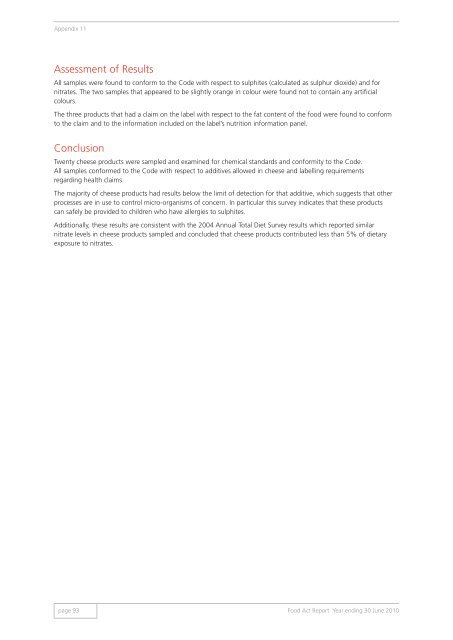Food Act Report 2009/2010 - SA Health - SA.Gov.au
Food Act Report 2009/2010 - SA Health - SA.Gov.au Food Act Report 2009/2010 - SA Health - SA.Gov.au
Appendix 11Two orange coloured cheese products were tested for artificial colours, including;• Allura Red AC• Amaranth• Azorubine• Erythrosine• Pouncea 4R• Sunset Yellow FCF• Tartrazine• Green S• Brilliant Blue FCF• IndigotineAdditionally, three products that had a claim regarding fat content on their label were analysed for fat content.ResultsTable 1. Additives in cheese productsProductSulphurdioxidemg/kgNitratesmg/kgCheddar Vintage 100
Appendix 11Assessment of ResultsAll samples were found to conform to the Code with respect to sulphites (calculated as sulphur dioxide) and fornitrates. The two samples that appeared to be slightly orange in colour were found not to contain any artificialcolours.The three products that had a claim on the label with respect to the fat content of the food were found to conformto the claim and to the information included on the label’s nutrition information panel.ConclusionTwenty cheese products were sampled and examined for chemical standards and conformity to the Code.All samples conformed to the Code with respect to additives allowed in cheese and labelling requirementsregarding health claims.The majority of cheese products had results below the limit of detection for that additive, which suggests that otherprocesses are in use to control micro-organisms of concern. In particular this survey indicates that these productscan safely be provided to children who have allergies to sulphites.Additionally, these results are consistent with the 2004 Annual Total Diet Survey results which reported similarnitrate levels in cheese products sampled and concluded that cheese products contributed less than 5% of dietaryexposure to nitrates.page 93Food Act Report Year ending 30 June 2010
- Page 41 and 42: Appendix 1DiscussionOf the 50 diffe
- Page 43 and 44: Appendix 2Appendix IIFood Safety Su
- Page 45 and 46: Appendix 2ResultsMicrobiological Re
- Page 47 and 48: Appendix 3Appendix IIIFood Safety S
- Page 49 and 50: Appendix 3ResultsProduct TypeB. cer
- Page 51 and 52: Appendix 4Appendix IVFood Safety Su
- Page 53 and 54: Appendix 4ResultsVegetable TypeSamp
- Page 55 and 56: Appendix 5Appendix VFood Safety Sur
- Page 57 and 58: Appendix 5ResultsTable 1. Microbiol
- Page 59 and 60: Appendix 6Appendix VIFood Safety Su
- Page 61 and 62: Appendix 6ResultsNumber Type of Fis
- Page 63 and 64: Appendix 7Appendix VIIFood Safety S
- Page 65 and 66: Appendix 7Notifications of Campylob
- Page 67 and 68: Appendix 7Discussion of ResultsEigh
- Page 69 and 70: Appendix 8Appendix VIIIFood Safety
- Page 71 and 72: Appendix 8Notifications of Campylob
- Page 73 and 74: Appendix 8General Labelling Require
- Page 75 and 76: Appendix 9Appendix IXFood Safety Su
- Page 77 and 78: Appendix 9In addition to mandatory
- Page 79 and 80: Appendix 9Sample Product Result3022
- Page 81 and 82: Appendix 9ConclusionThis is the fir
- Page 83 and 84: Appendix 10Appendix XFood Safety Su
- Page 85 and 86: Appendix 10Table 1: Guideline level
- Page 87 and 88: Appendix 10BusinessProductSPC(at 30
- Page 89 and 90: Appendix 11Appendix XIFood Safety S
- Page 91: Appendix 11StandardsThe Food Act 20
- Page 95: For more informationFood Policy and
Appendix 11Assessment of ResultsAll samples were found to conform to the Code with respect to sulphites (calculated as sulphur dioxide) and fornitrates. The two samples that appeared to be slightly orange in colour were found not to contain any artificialcolours.The three products that had a claim on the label with respect to the fat content of the food were found to conformto the claim and to the information included on the label’s nutrition information panel.ConclusionTwenty cheese products were sampled and examined for chemical standards and conformity to the Code.All samples conformed to the Code with respect to additives allowed in cheese and labelling requirementsregarding health claims.The majority of cheese products had results below the limit of detection for that additive, which suggests that otherprocesses are in use to control micro-organisms of concern. In particular this survey indicates that these productscan safely be provided to children who have allergies to sulphites.Additionally, these results are consistent with the 2004 Annual Total Diet Survey results which reported similarnitrate levels in cheese products sampled and concluded that cheese products contributed less than 5% of dietaryexposure to nitrates.page 93<strong>Food</strong> <strong>Act</strong> <strong>Report</strong> Year ending 30 June <strong>2010</strong>



